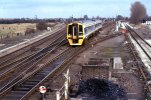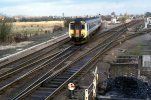I am not very familiar with turnout speeds, but can you advise are there standard 'off the shelf' turnouts and for a few common speeds?
Yes there are standard designs for all speeds of turnout. To add t9 the fun there are also non-standard designs, where standard designs don’t fit.
And what might the cost of a standard 50mph turnout be compared to a slow speed turnout, say 20mph (Carlisle South approach is full of them)
Good question. The cost of a turnout varies by a number of factors. I’ll do the simple version:
The cost of the turnout itself - materials and installation - is typically related to the length of the unit. Longer turnouts need more material, but also more digging out of the old stuff on installation so takes more effort. The length of the turnout is related to speed: faster = longer; substantially so once you go above 50mph. Turnout lengths will also vary depending on curvature of the ‘straight’ route and some other factors.
BUT -if you are having to renew the track because it is all life expired, it is likely that the adjacent plain lien is also life expired, so it needs digging up anyway. Therefore in some cases installing longer / faster turnouts actually doesn’t cost much extra.
However....
If it was just track it would be easy. It isn’t. There is also signalling, electrification, and often geography in the way. Using Ely as the example, the Junction used to be double in all directions, but it also used to be about 20mph for most of them. In the 1990s remodelling, prioritising the line to Peterboro’, and making the others single lead allowed the speed to be increased within the available railway land (I know the chap who designed it). It simply wasn’t (and still isn’t) possible to have double junctions and high speed. That’s why the current proposal for improving the Junction will need land take.
Just to go back to signalling, if you replace a 20mph turnout with a 50 mph version, the extra length will mean changes to the signalling system. As a minimum it means changes to train detection (track circuits or axle counters), and more often than not signals have to move. It is also quite likely that doing this in a complex area (such as the Carlisle South example you mentioned) would have a knock on to other parts of the layout which means more work, and potentially changing the interlocking. And that’s means you are effectively resignalling. And with a big change, that also means complete replacement of the electrification in the area too (if it has electrification, of course). So the costs very quickly add up.
To put some very rough numbers on it - renewing one simple 20mph crossover like for like would cost about £2m; putting in a 50mph crossover would be about £2.5m-£3m if it didn’t need any changes to signalling or electrification, but if it did it could easily be £5m+.





